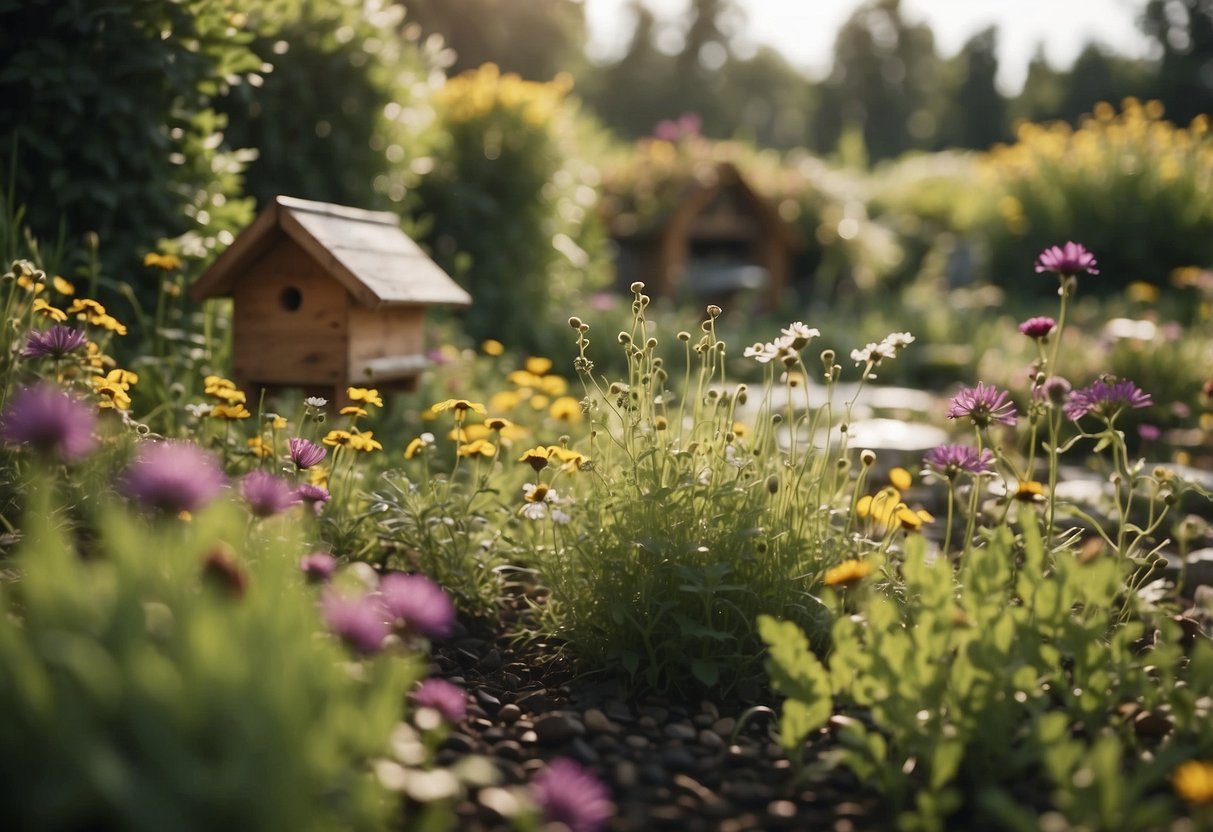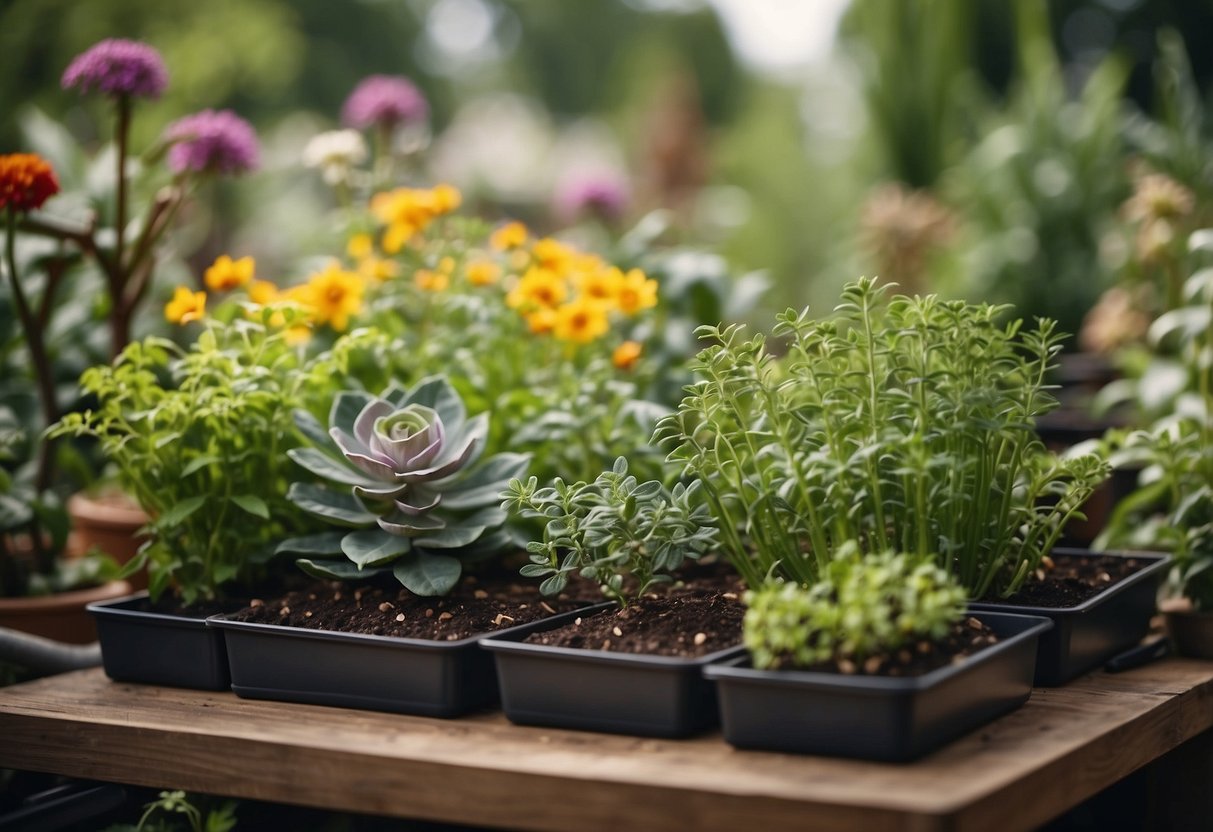Eco Garden Project Ideas: Creative and Sustainable Tips
Taking steps to create an eco-friendly garden enhances your outdoor space while benefiting the environment. This article will explore various project ideas that can help you make your garden more sustainable. By adopting eco-friendly practices, you can enjoy a beautiful garden and contribute to a healthier planet.

Whether you are a seasoned gardener or just starting out, there are plenty of simple and effective eco-garden projects you can try. From water conservation to plant selection, these projects are designed to help you make a positive impact with your gardening efforts. Dive into the world of eco-gardening and discover how easy it can be to go green in your backyard.
1) Vertical Herb Garden

A vertical herb garden is a great way to save space and grow your favorite herbs. You can use mounted mason jars or hanging shelves with terra-cotta pots to create a unique display.
With a sunny wall, your herbs will thrive and provide fresh ingredients for your cooking. Regular watering and occasional fertilizer will keep them healthy and lush. You’ll enjoy fresh herbs year-round in even the smallest spaces.
2) Rain Barrel System

A rain barrel system is a great way to save water and reduce your water bill. By collecting rainwater from your roof, you can use it for watering your garden or washing your car.
You can make a rain barrel from a variety of materials. For example, you can turn an old garbage can into a DIY rain barrel.
Setting up a rain barrel is simple. Attach a spigot for easy access to the water and place it under a downspout to collect rainwater. This eco-friendly project is not only practical but also helps conserve valuable resources.
3) Compost Bin Setup

Setting up a compost bin is simple and rewarding. You can build your own using materials like wood or plastic containers.
A DIY compost bin made from 5-gallon buckets is perfect for small spaces.
Another great option is creating a compost bin from reclaimed wood, which adds a rustic touch to your garden.
With a little effort, you can turn kitchen scraps into rich soil for your plants.
4) Butterfly Sanctuary

To create a butterfly sanctuary, plant milkweed for Monarch butterflies. It provides food for caterpillars and attracts adults.
Place your garden where sunlight hits early in the day. This helps butterflies warm up quickly.
Set up puddling stations. Adding a pinch of salt or fruit juice can provide butterflies with extra nutrients.
Group plants in drifts of 3-5 to create larger swaths of color. This makes it easier for butterflies to spot them.
5) Bee-Friendly Flower Bed

Adding a bee-friendly flower bed to your garden is a great way to support pollinators. Bees love bright colors and fragrant flowers. Native wildflowers, sunflowers, and flowering herbs are excellent choices.
Make sure your garden gets enough sunlight. Aim for at least six hours of sun each day. This helps bees stay warm and active.
Avoid using pesticides. Chemicals can harm bees. Instead, use natural alternatives to keep your plants healthy.
Including plants like thyme, which thrives in well-drained soil, can provide bees with the foraging opportunities they need to thrive.
Start planting and watch your garden buzz with life!
6) Raised Vegetable Planters

Raised vegetable planters are a great way to grow your own food. They keep your plants organized and make gardening easier on your back.
You can make a simple frame with wood or even use old pallets. A tiered design adds a stylish look and lets you plant more in a smaller space.
Check out some inexpensive raised garden bed ideas that use cedar fencing and other materials you might already have at home.
7) DIY Worm Farm

Creating a DIY worm farm is a fun and eco-friendly project. It helps recycle kitchen waste and improves your garden soil.
Start with two bins and a drill. Make holes in the lids to allow air in. Cut strips of newspaper for bedding.
Add food scraps and red wiggler worms. They’ll break down the compost, with water dripping to the bottom. Cover with the second bin.
You can even make an underground worm farm using PVC pipe or buckets. Just remember to keep the worms fed and the bedding moist!
8) Solar Powered Water Feature

A solar powered water feature can add charm to your garden while being environmentally friendly.
You can use different containers like ceramic pots, terracotta saucers, or pedestal bowls. These containers keep the water in and add a unique touch to your garden decoration.
A solar pump powers the fountain. This means you won’t need any electricity, just sunlight. It’s a simple and effective way to make your garden more lively. For a detailed guide, check out this DIY project.
9) Greenhouse with Recycled Materials

Creating a greenhouse with recycled materials is a fun and eco-friendly project.
You can use old windows to build the structure. These windows allow sunlight in and help keep the warmth.
Another idea is using storm doors. These are great for trapping heat and providing sturdy support.
For a unique touch, consider a greenhouse made from recycled plastic bottles. It’s a creative way to reuse plastic.
Building with pallets and old windows is also popular. Pallets form a strong base, and windows complete the structure.
Check out these DIY plans from Sustainablog and ideas from Off Grid World for inspiration.
10) Native Plant Garden

A native plant garden is a great way to support local wildlife. By choosing plants that are native to your region, you help create a balanced ecosystem.
You can find native plant lists and design ideas for your specific area through resources like Wild Ones and Grow Native!.
Using native plants reduces the need for pesticides and fertilizers. This makes your garden more eco-friendly and easier to maintain. Plus, these plants are well adapted to your local climate and soil conditions, which means they’ll thrive with less effort.
Benefits of Eco Gardening

Eco gardening offers numerous advantages that include positive effects on the environment and improvements to your personal health.
Environmental Impact
Eco gardening practices can significantly benefit the environment. By using rainwater collection systems, you reduce water waste. Collecting rainwater in containers or barrels helps conserve this valuable resource and is an effective way to water your garden without increasing your water bill.
Implementing companion planting is another great practice. Certain plants grow better together and can naturally repel pests, reducing the need for chemical pesticides. This keeps the soil healthier and more fertile.
Additionally, creating a wildlife-friendly garden encourages biodiversity. Birds, bees, and other pollinators thrive in such environments, helping to support the larger ecosystem. Planting native species is particularly beneficial because they are adapted to the local climate and require less maintenance.
Health Advantages
Creating an eco-friendly garden also has several health benefits for you. Growing your own fruits and vegetables can lead to a healthier diet. Fresh produce from your garden is often more nutritious and free from harmful pesticides.
Gardening itself is a form of exercise. The physical activity involved in planting, weeding, and harvesting can improve your fitness levels and mental well-being. Spending time outdoors in your garden can also reduce stress and boost your mood.
Being in contact with nature can enhance your mental health as well. The sights, sounds, and smells of a garden can provide a peaceful environment, making it easier for you to relax and unwind from daily stressors.
Planning Your Eco Garden

Creating an eco garden starts with selecting native plants and designing a sustainable layout. Both of these steps are crucial for ensuring your garden supports local wildlife and conserves resources.
Selecting Native Plants
Native plants are those that naturally occur in your region. They have adapted to the local climate and soil conditions, making them easier to grow and maintain. By choosing native plants, you minimize the need for artificial fertilizers and pesticides. These plants are more resistant to local pests and diseases, reducing the need for chemical interventions.
Native plants also provide better habitat for local wildlife. Birds, insects, and other creatures rely on native plants for food and shelter. This helps to create a balanced ecosystem in your garden. When selecting plants, look for species that thrive in your specific climate and soil type. Local nurseries or botanical gardens can be great resources for finding native plants.
Creating a Sustainable Design
Designing a sustainable garden involves thinking about water conservation, soil health, and energy use. Start by planning the layout to include areas for water collection, such as rain barrels or swales. Use permeable surfaces like gravel or mulch paths to reduce water runoff and promote groundwater recharge.
Incorporate companion planting to enhance soil health and deter pests naturally. For example, plant marigolds among your vegetables to repel nematodes. Mulching is another effective strategy; it helps retain soil moisture and suppress weeds, reducing the need for irrigation and herbicides.
Consider using reclaimed materials for garden structures like trellises or raised beds. This reduces waste and gives your garden a unique, eco-friendly touch. Lastly, choose energy-efficient tools and lighting to reduce your garden’s carbon footprint. By focusing on these elements, you can create a garden that is both beautiful and sustainable.
Maintenance and Care

Proper maintenance and care ensure your eco-friendly garden thrives. By focusing on water conservation and organic pest control, you can maintain a healthy and sustainable garden.
Water Conservation Techniques
Efficient water use is key. One of the most effective methods is collecting rainwater using a water butt or a large container. This helps reduce dependency on tap water and utilizes natural resources.
Consider installing a drip irrigation system. This method delivers water directly to plant roots, minimizing evaporation and waste. Another technique is mulching, which retains soil moisture and reduces the need for frequent watering. You can use organic materials like straw, leaves, or compost.
Don’t forget to water plants early in the morning. This helps reduce evaporation and allows plants to absorb moisture throughout the day. Additionally, choose drought-resistant plants that require less water, making your garden more sustainable.
Organic Pest Control
Managing pests naturally protects both your garden and the environment. Companion planting is a great method. Some plants naturally repel pests, so pairing them with your vegetables can reduce pest problems. For example, planting marigolds with tomatoes can deter nematodes.
Homemade sprays made from ingredients like garlic, chili, or neem oil can be effective in repelling pests without harming beneficial insects.
Encouraging natural predators is also important. Birds, ladybugs, and spiders help control pest populations. You can attract these helpful creatures by providing food sources and habitats, such as bird feeders and bug hotels.
Regularly inspecting your plants for signs of pests and addressing issues early can prevent infestations. By focusing on these methods, you can keep your garden healthy and thriving without the need for harsh chemicals.







